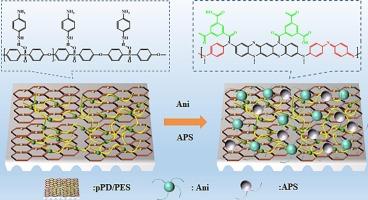Efficient separation of phosphate ions from water across a wide pH range using a triphenylamine-p-phenylenediamine/TMC composite membrane
IF 6.9
2区 材料科学
Q2 CHEMISTRY, PHYSICAL
引用次数: 0
Abstract
The persistent accumulation of phosphate ions in wastewater, which leads to eutrophication, has garnered substantial attention within the scientific community. Nanofiltration (NF) membranes are widely used for water treatment due to their simplicity, effective multivalent ion rejection, and absence of phase change; however, their practical application is limited by the “trade-off effect” and poor antifouling performance. Therefore, the development of membrane materials that simultaneously enhance rejection efficiency, flux, and anti-fouling performance is of great practical significance. In this study, polyaniline (Ani) and para-phenylenediamine (pPD) were polymerized in situ on a polyethersulfone (PES) support using ammonium persulfate as the oxidant to synthesize PAPD. Subsequently, PAPD was integrated with trimesoyl chloride through interfacial polymerization, thereby fabricating a PAPD/PES composite nanofiltration membrane specifically designed for phosphate separation. The membrane surface featured protruding structures with nanoscale particulate characteristics. At ambient temperature, under an operational pressure of 2.5 bar, with a solution pH of 9 and an initial phosphate concentration of 10 mg L–1, the membrane flux reached 58.15 L m–2h−1 bar−1, with a phosphate rejection of 81.86 %. Stability tests confirmed excellent structural durability. In real wastewater containing 1.03 mg P L–1, the membrane reduced phosphate to 0.51 mg P L–1, meeting China’s Grade B discharge standard (1.0 mg P L–1). This work demonstrates that the PAPD/PES composite membrane, modified with Ani and pPD, provides enhanced phosphate rejection, high flux, and robust antifouling performance, offering a promising strategy for efficient water treatment and potential industrial-scale applications.

使用三苯胺-对苯二胺/TMC复合膜在宽pH范围内有效地从水中分离磷酸盐离子
磷酸盐离子在废水中的持续积累,导致富营养化,已经引起了科学界的广泛关注。纳滤膜(纳滤膜)因其简单、有效的多价离子过滤和无相变而被广泛应用于水处理;然而,它们的实际应用受到“权衡效应”和防污性能差的限制。因此,开发同时提高截除效率、通量和抗污染性能的膜材料具有重要的现实意义。本研究以聚醚砜(PES)为载体,以过硫酸铵为氧化剂,原位聚合聚苯胺(Ani)和对苯二胺(pPD)。随后,通过界面聚合将PAPD与三甲酰氯结合,制备出专门用于磷酸盐分离的PAPD/PES复合纳滤膜。膜表面具有纳米级颗粒特征的突出结构。在常温下,操作压力为2.5 bar,溶液pH为9,初始磷酸盐浓度为10 mg L - 1,膜通量为58.15 L m-2h−1 bar−1,磷酸盐去除率为81.86 %。稳定性测试证实结构耐久性极佳。在含有1.03 mg P - 1的实际废水中,该膜将磷酸盐还原为0.51 mg P - 1,达到中国B级排放标准(1.0 mg P - 1)。该研究表明,用Ani和pPD改性的PAPD/PES复合膜具有增强的磷酸盐截除率、高通量和强大的防污性能,为高效水处理和潜在的工业规模应用提供了一个有前途的策略。
本文章由计算机程序翻译,如有差异,请以英文原文为准。
求助全文
约1分钟内获得全文
求助全文
来源期刊

Applied Surface Science
工程技术-材料科学:膜
CiteScore
12.50
自引率
7.50%
发文量
3393
审稿时长
67 days
期刊介绍:
Applied Surface Science covers topics contributing to a better understanding of surfaces, interfaces, nanostructures and their applications. The journal is concerned with scientific research on the atomic and molecular level of material properties determined with specific surface analytical techniques and/or computational methods, as well as the processing of such structures.
 求助内容:
求助内容: 应助结果提醒方式:
应助结果提醒方式:


